Just as we don’t know the cost to deliver your solutions or services, we don’t expect you to know how much it costs to design a website. So with that in mind, we wrote a short primer to shed some light on the situation, and answer the popular questions we often hear from our clients.
But first some caveats…
Website Design Costs Can Vary Greatly
We build 100% custom websites for our clients, and that’s the type of website we are discussing in this article. What does that mean? Every Peaktwo website is a unique design, purposefully-built around our client’s brand, market, and business goals. We do not work with drag-and-drop theme builders such as Elementor or Divi – and that’s not to say that theme builders aren’t good options. In our experience, custom sites built in Gutenburg or using Advanced Custom Fields (ACF) or similar, better align with the growing needs of our clients and their teams. [Note: There are also many great DIY site options for small businesses, such as Squarespace, GoDaddy Page Builder, and Wix, that if you have the time (or a creative family member), are fast and easy solutions.]
There are clear benefits to each approach, but that’s an article for another day, this one is about how much you should expect to spend for a new website. To which we have stock consultant answer cued up “it depends.”
It really does. It depends on your goals (…are you educating visitors or expecting leads?), your solution (…are you selling SaaS software or car parts?), your audience (are you targeting multiple decision makers in an organization or a single persona?), your team size (do you have the staff to support building custom graphics or writing original content?), and the “depends” list goes on.
To understand what it costs to build your website, it’s best to start with the stage of your business and the role it will play. To break it down, we’ve grouped the most common website types into three types: The Starter Site, The Transition Site, and The Destination Site.
Web Design Type 1: The Starter Site
The objective of this site is to firmly establish your business in the market. It is frequently the site built when you are serious about launching or growing your business. Alternatively, it could be a “microsite” with a special purpose (i.e. a user conference, careers portal, or temporary brand site). You are probably in growth mode, starting to market your business to a larger audience, and hiring additional employees. For these clear goals, having a focused, well-conceived, and professional website destination is essential.
- 15+ Page Website
- Sample Primary Pages: Homepage, Services, Blog, Company, Careers, Contact
- Key Features & Functionality: Custom Design, Content Management System, Form Submissions, SEO Fundamentals, and more.
- Time to Build: 2 – 3 Months
- Cost: $15,000 – $30,000
Web Design Type 2: The Transition Site
Larger, more established businesses that are looking to expand their reach, share original content, generate leads, or improve search performance are better suited for a Transition Site. Organizations requiring this kind of site are often selling into a very competitive market with similar offerings. A clearly defined strategy, story, and design are important for these sites to be successful. These sites are powerful web platforms built on scalable content management platforms, with plenty of features for data capture and engagement. Designs are more robust and interactive than on a Starter Site and aim to be flexible, scalable for growth, and easy to use for internal teams to manage.
- 150+ Page Website
- Sample Primary Pages: Starter Site pages PLUS Individual Product/Services, Industries, Case Studies, Blog, Careers, Leadership, New & Press, Partners, Campaign Landing Pages
- Key Features & Functionality: Content Management System, Level I CRM Integration (Salesforce or Hubspot), Resource Center, Privacy & GDPR Settings, 3rd-Party Script Integrations, SEO Migration Plansand more.
- Time to Build: 4 – 6 Months
- Cost: $50,000 – $80,000
Web Design Type 3: The Destination Site
Websites in this category are an integral part of an organization’s business operations with a clear relationship to bottom-line revenue. These websites are fully-integrated into the marketing and sales functions, and may even cater to customers, offering user access to customer accounts. Destination Sites offer multiple, clearly defined user paths and areas to support the top, middle and bottom of the sales funnel. They are rich in content and have robust Learning Centers for finding and engaging with original thought leadership. The Destination Site is a primary asset for large, financially-stable organizations.
- 500+ Page Website
- Sample Primary Pages: Starter & Transition Site pages PLUS International Sites, Subdirectory Sites, User Communities, HR Portal, Product Directory, Investor Information, Learning Management Systems
- Key Features & Functionality: Content Management System, Multi-lingual Capabilities, eCommerce, Level II CRM Integration, Robust Resource & Events Center, ADA Accessibility, Custom API Integrations, Client Areas w/ Account Login, GDPR & Cookie Policy, SEO Migration Plans, and more.
- Time to Build: 6+ Months
- Cost: $100K+
What Else Influences the Cost of Website Design?
Know that you know the basics and where your website may land, what else goes in the cost of a website design? Are there hidden fees? It’s not always clear, and that’s why you need to know what to ask up front. Here are a few areas of a new website project that you may consider, and should definitely ask about when speaking with a potential agency partner:
Copywriting
Who is going to write the copy to fill all these beautiful pages? Do you have in-house capabilities? If not, ask your agency if they do, or if they can find you a writer.
Content Loading
Would you believe some agencies will deliver you a website with no content loaded? It happens. Ask in advance who is responsible for content loading.
Content Migration
How will you get your legacy resource content (blogs, events, webinars, videos, etc.) into the new website? Some systems offer import/export capabilities, others require custom scripts.
Photography & Video
Need new headshots? Hate stock photos? Think about where you’ll acquire your visual assets and the timing required to create them.
Custom Illustrations
This is a big one. If you’re in SaaS, you LOVE custom illustrations and animation. Here’s the rub – these are expensive and time-consuming. Most likely, it’s not included in your website project.
Accessibility
ADA compliance is a major requirement of government websites, and many corporations are following suit. Depending on your level of compliance, your agency can design to specifications or you may choose to use a tool like AccessiBe to meet all your needs.
SEO Optimization
How’s your current site performing in search? If it’s good, you need a migration plan. If it’s bad, you need the new site to be built with core SEO fundamentals and at a minimum, titles and meta descriptions.
Hosting
Where will this new website live and who will manage and maintain it? Simple sites need simple hosting solutions. Complex sites need a lot more. It’s a discussion you’ll want to have very early in your project kickoff.
Legal
Cookies! Privacy! GDPR! Guess what? Your web design agency is not a legal team, so don’t rely on them to give you the most complete answer. It’s always best to consult your attorney.
—–
Ready to get started on your new site? We’d love to join you on the journey!


